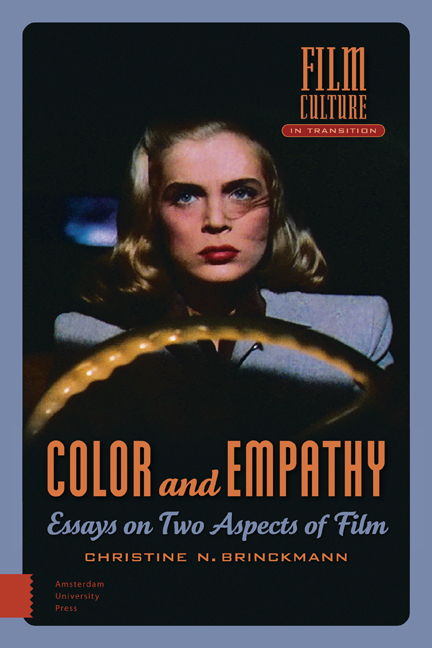Book contents
- Frontmatter
- Contents
- Preface
- Dedication
- Cinematic Color as Likeness and as Artifact: [2001]
- Chords of Color: [2006]
- The Tension of Colors in Colorized Silent Films: [2001]
- Structural Film, Structuring Color: Jenny Okun's Still Life: [1995]
- Desert Fury: A Film Noir in Color: [2012]
- The Work of the Camera: BEAU TRAVAIL: [2005]
- Empathy with the Animal: [1997]
- Motor Mimicry in Hitchcock: [1999]
- Abstraction and Empathy in the Early German Avant-garde: [1997]
- The Role of Empathy in Documentary Film: A Case Study: [2005]
- Genre Conflict in Tracey Emin’s Top Spot: [2007]
- Viewer Empathy and Mosaic Structure in Frederick Wiseman’s PRIMATE: [2009]
- CASTA DIVA: An Empathetic Reading: [2008]
- Publication Data
- Index of Films
- Index of Subjects
- Film Culture in Transition
Desert Fury: A Film Noir in Color: [2012]
Published online by Cambridge University Press: 23 June 2021
- Frontmatter
- Contents
- Preface
- Dedication
- Cinematic Color as Likeness and as Artifact: [2001]
- Chords of Color: [2006]
- The Tension of Colors in Colorized Silent Films: [2001]
- Structural Film, Structuring Color: Jenny Okun's Still Life: [1995]
- Desert Fury: A Film Noir in Color: [2012]
- The Work of the Camera: BEAU TRAVAIL: [2005]
- Empathy with the Animal: [1997]
- Motor Mimicry in Hitchcock: [1999]
- Abstraction and Empathy in the Early German Avant-garde: [1997]
- The Role of Empathy in Documentary Film: A Case Study: [2005]
- Genre Conflict in Tracey Emin’s Top Spot: [2007]
- Viewer Empathy and Mosaic Structure in Frederick Wiseman’s PRIMATE: [2009]
- CASTA DIVA: An Empathetic Reading: [2008]
- Publication Data
- Index of Films
- Index of Subjects
- Film Culture in Transition
Summary
Film noir owes its name not least to its distinctive, somber black-and-white photography. High-contrast shots in the low-key lighting style, in which black can swallow up entire areas of the image and prominent shadows structure the composition, became the supreme form over the course of the 1940s. The ascendancy of film noir was due to expressionist influences from European immigrants among the camera operators, but also points to an awareness of the beauties of the black-and-white film at a time when color was beginning to prevail. Above all, however, low-key lighting, which traditionally was characteristic of dark moods and whole genres such as the gangster film and the war film, was now further refined and more consistently deployed in order to conform to the atmosphere of the films.
In the controversy over whether film noir is a genre, a cycle, or a style, the fact that light plays such a central role causes the pendulum to swing toward style. And so diverse works that would otherwise be categorized as thrillers, woman's films, melodramas, revenge plays, or police films are assigned to this corpus because their lighting clearly speaks the noir language. But patterns for narrative structures and the creation of characters may also condense into a style and infiltrate other traditions of the feature film: subjectivity, voice-over, flashbacks, and dream scenes together with psychologically unstable or criminal protagonists are typical of this trend. Thus, it is difficult to make clear generic distinctions, and it is little wonder that, beyond a small number of core examples, the film noir canon varies from one film historian to the next.
It is, however, striking that the few films with noir qualities that are shot in color rather than black-and-white hardly ever appear on any of the influential lists. For example, the film to be analyzed below, Desert Fury (Lewis Allen, 1947), was long ignored by the scholarship on film noir:
DESERT FURY? You haven't heard of it? […] A 1947 Paramount release starring Lizabeth Scott and Burt Lancaster, this turgid melodrama about a gambling casino owner's daughter infatuated with an underworld gambler suspected of murder figures in no known pantheon or cult. Its director, Lewis Allen, is devoid of auteur status. Its performances are, by and large, not of award-winning stature.
- Type
- Chapter
- Information
- Color and EmpathyEssays on Two Aspects of Film, pp. 89 - 108Publisher: Amsterdam University PressPrint publication year: 2014



